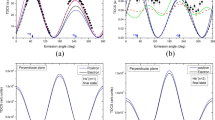Summary
A theory of the polarization effects in the energy loss of a charged particle is given, in which the mechanism of the loss is different from that of the Fermi theory. This theory leads to a distribution of the loss between ionization-excitation and emission of Cerenkov radiation which differs considerably from that of the theories on Fermi’s lines, although the stopping power is not essentially changed, being somewhat less than in those theories. This treatment leads to an increase of the direct ionization at impact parameters larger than atomic dimensions after the relativistic minimum, the increase being large in the case of gases. The Fermi saturation effect of the loss at distances larger than atomic dimensions does also exist in the present theory, although due to a different mechanism. The relativistic increase of the loss in distant interactions is due largely to an increase of the radii of action for ionization and excitation (Bohr-Williams mechanism), but there is also a contribution of the Cerenkov radiation (Fermi mechanism). The saturation arises from a limitation of the increase of the radii of action due to the polarization of the medium and to the saturation of the emission of Cerenkov radiation. This theory leads to a modification of the formula of Frank and Tamm for the rate of emission of Cerenkov radiation, the emission of high energy Cerenkov radiation being considerably reduced.
Riassunto
Si formula una teoria della perdita d’energia di una particella carica, in cui il meccanismo della perdita è differente da quello della teoria di Fermi. La nostra teoria conduce a una distribuzione della perdita tra l’eccitazione per ionizzazione e l’emissione di radiazione Cerenkov che differisce notevolmente da quelle delle teorie del tipo di quella di Fermi, per quanto il potere di frenamento non sia essenzialmente diverso, essendo soltanto nella nostra teoria alquanto minore che in quelle. Questo trattamento conduce a un aumento della ionizzazione diretta per parametri d’urto maggiori delle dimensioni atomiche dopo il minimo relativistico, l’aumento essendo considerevole nel caso dei gas. L’effetto di saturazione di Fermi della perdita a distanze superiori alle dimensioni atomiche esiste anche nella nostra teoria, per quanto in virtù di un differente meccanismo. L’aumento relativistico della perdita nelle interazioni a distanza è dovuto largamente a un aumento dei raggi d’azione per la ionizzazione e l’eccitazione (meccanismo di Bohr-Williams), ma è dovuto anche a un contributo della radiazione di Cerenkov (meccanismo di Fermi). La saturazione è dovuta a una limitazione dell’aumento dei raggi d’azione dovuta alla polarizzazione del mezzo e alla saturazione dell’emissione di radiazione Cerenkov. La presente teoria conduce a una modificazione della formula di Frank e Tamm per il tasso d’emissione della radiazione Cerenkov, l’emissione di radiazione Cerenkov di elevata energia essendo considerevolmente ridotta.
Similar content being viewed by others
References
E. Fermi:Phys. Rev.,57, 485 (1940).
G. C. Wick:Ric. Scient.,11, 273 (1940);12, 858 (1941),Nuovo Cimento,1, 302 (1943).
O. Halpern andH. Hall:Phys. Rev.,57, 459 (1940);73, 477 (1948).
A. Bohr:Det. Kgl. Dans. Vid. Sels.,24, n. 19 (1948).
M. Schönberg:Bull. Cent. Phys. Nucl. Brux., n. 20 (1950).
M. Schönberg:Nuovo Cimento,8, 159 (1951).
G. P. S. Occhialini:Como Congress (Nuovo Cimento, Suppl.,6, 377 (1949).
H. Messel andD. M. Ritson:Phil. Mag.,41, 1129 (1950).
I. Frank andI. Tamm:Compt. Rend. Ac. Sci. USSR,14, 109 (1937);I. Tamm:Journ. of Phys. USSR,1, 439 (1939).
P. H. Fowler:Phil. Mag.,41, 169 (1950);U. Camerini, P. H. Fowler, W. O. Lock andH. Muirhead:Phil. Mag.,41, 413 (1950).
T. Bowen andF. X. Roser:Phys. Rev.,83, 689 (1951).
L. Voyvodic:Bristol Conference (1951);E. Pickup andL. Voyvodic:Phys. Rev.,80, 89 (1950).
S. G. Gosh, G. M. D. B. Jones andJ. G. Wilson:Proc. Phys. Soc.,65, 68 (1952).
M. Schönberg:Nuovo Cimento,9, 210 (1952).
M. Schönberg:Nuovo Cimento,9, 372 (1952).
H. Bethe:Zeits. f. Phys.,76, 293 (1932);Ann. d. Phys.,5, 325 (1930);F. Bloch:Ann. d. Phys.,16, 285 (1933);Zeits. f. Phys.,81, 363 (1933);C. Möller:Ann. d. Phys.,14, 531 (1932);E. J. Williams:Proc. Roy. Soc., A135, 108 (1932).
E. J. Williams:Proc. Roy. Soc., A139, 163 (1933).
A. H. Morrish:Phil. Mag.,43, 533 (1952).
L. Jauneau andF. Hug-Bousser:Journ. de Phys. (in press).
Author information
Authors and Affiliations
Additional information
Traduzione a cura della Redazione.
Rights and permissions
About this article
Cite this article
Huybreghts, M., Schönberg, M. Ionization at relativistic energies and polarization effects. Nuovo Cim 9, 764–807 (1952). https://doi.org/10.1007/BF02780931
Received:
Published:
Issue Date:
DOI: https://doi.org/10.1007/BF02780931




